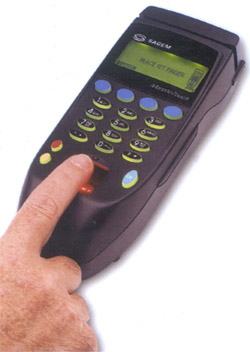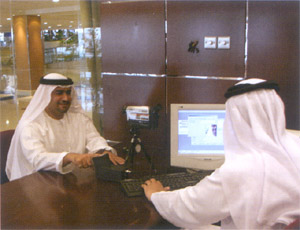
Dubai International Airport is harnessing the latest
fingerprint technology to speed up
immigration procedures. Ben Smalley looks at the new system and how fingerprints are being
increasingly used to protect the identity
and rights of individuals around the
world.
After a long and tiring overseas flight all you want is to
get home and relax - the last thing you
want to do is join a long queue and wait
in line for what can seem like an eternity
to pass through immigration control and
have your passport checked.
There is nothing worse than arriving at Dubai
International Airport at the same time as
a dozen other flights and being faced with
queues stretching the length of the
immigration hall.
But help is at hand thanks to the latest in
biometric technology - it is now possible
to simply run a smart card through a
reader and place two fingers on an optical
sensor, which will check your fingerprints
against the information stored on the
card, for immediate immigration clearance
at arrivals and departures.
The new system has been developed by the Dubai
Naturalisation and Residency Department (DNRD)
under the directives of General Sheikh
Mohammed bin Rashid Al Maktoum, Dubai
Crown Prince and UAE Defence Minister, and
Sheikh Ahmed bin Saeed Al Maktoum,
President of Dubai Civil Aviation and
Chairman of Emirates, to speed up
immigration procedures.
Travellers wanting to use the new system must
first register at the enrollment office
set up at the airport and have their
details stored on the database, including
a digital scan of their unique
fingerprints. They will then be issued
with a smart card, which contains all the
information needed to prove their
identity, and can then use the automated
entry and exit gates to ‘fast-track’
through immigration.
The automated system, the first of its kind in
the Middle East and a relatively new
global concept, is a timely addition to
the facilities at Dubai airport, which is
ranked as the busiest in the region and
one of the fastest growing airports in the
world.
Despite the impact of global events, Dubai
airport registered a 10 per cent growth in
passenger numbers in 2001 with 13.5
million people passing through the
airport. Future projections anticipate
continued growth to 30 million passengers
by 2010, making the introduction of an
automated immigration clearance system a
time saving asset for both the authorities
and passengers.
Colonel Saeed Bin Belaila,
Director of the DNRD, said: “This
enormous volume of passengers and the
resulting documentation procedures would
become increasingly difficult to handle
unless an organised system is in place to
oversee all aspects of passenger movement,
which is why we have devised this system
of automated electronic gates that will
not only speed up the registration of
travellers through the airport but also
act as a significant barrier for illegal
entrants.”

The information system that
manages the whole process, including the
electronic gate control, fingerprints and
card issue, has been devised and developed
in-house by the DNRD.
Major Khalid Majid Lootah, Head of
the IT Section, said: “The electronic
gate system is the result of over 10
months of concerted effort by the staff of
our in-house IT department and has been
devised using enhanced technologies which
ensure that the service rendered is
extremely accurate. It is also a very
important move to curb fraud and
impersonation at the entry and exit levels
as the gate will only allow those
passengers into the system whose
fingerprints match the enrolled
identifications.”
He added: “The fact that we have
not outsourced the information management
system has also saved the DNRD over 70 per
cent of the initial costs, in addition to
60 per cent per gate. The only components
of the equipment that have been outsourced
are the gates, the fingerprint system, and
the ID cards.”
The unique and unalterable
patterns of every person’s fingerprints have been used in the fight against crime by
police forces all over the world since the beginning of the 20th
century, but their systematic use for
civil purposes dates back even further.
In 1858, William Herschel, the British
governor of Bengal, was so exasperated by
the fact that the contracts he signed were
never honoured that he decided to get one
of his suppliers to place a palm print of
his hand on an order for equipment. A few
years later, in 1877, when he was the
pensions administrator in Calcutta,
Herschel implemented a system for
authenticating the payment of pensions
based on fingerprints.
Only years later, at the end of the 19th
century, did the British police seize upon
the idea to identify criminals, and
particularly habitual offenders, by their
fingerprints. The system proved so
effective that the United States, France
and other countries very quickly followed
the example set by Scotland Yard.
In 1964, again in Britain, someone had the
idea of processing fingerprints by
computer and that technology has now
advanced to such a stage that fingerprint
identification systems have been developed
for use in other government fields –
such as securing the production of ID
documents and paying social security or
welfare benefits - as well as a wide range
of commercial, industrial and private
uses, including monitoring employee time
and attendance, controlling access to
buildings and computers, enabling secure
commercial transactions, and more
recently, airport security.
One of the leading companies in the field
of automated fingerprint processing
technology is Sagem, whose systems are
used in over 40 countries around the
world.
A
spokesman for the French company said: “
Today,
more than ever, airport security needs to
be completely reappraised. With a daily
flow of between 100,000 and 200,000
passengers, and a staff of several tens of
thousands, the population of a large
airport is as difficult to manage as that
of a city.
“The situation is made even more complex
by the fact that these figures are
constantly increasing and existing
security systems are no longer sufficient.
Throughout the world, whether they deal
with international, internal, business
flights or general aviation, airports need
to reorganise to strengthen security in
terms of equipment and procedures. Making
air transport safe requires a joint
commitment by airports, airlines and all
the civil aviation authorities, including
the police, immigration services and
customs.”

Checking people’s identity is one of the
cornerstones of airport security and
systems can be introduced so fingerprints
can be scanned, and passenger identity
quickly verified, at check-in desks, when
using loyalty cards, at passport control,
on entering exclusive airport lounges and
on boarding the aircraft to ensure the
person travelling is who he or she says
they are, and that the person who
checked-in is the same person boarding the
plane. Equally, the principal can be
applied to airport staff to ensure that
only authorised people access restricted
areas, log-on to sensitive computers, or
use service or refuelling vehicles, for
example.
“Biometrics is the only reliable
solution for protecting the identity and
the rights of individuals, because it
recognises unique and unalterable
features,” the Sagem spokesman said.
“Recently, we have started marketing a
range of commercial biometric products,
particularly for access control, the
technology of which has emerged directly
from the most advanced algorithms
developed for State security.”
When enrolling for a fingerprint
recognition system, applicants are
required to place two fingers on an optic
sensor and the image of his or her
fingerprints are immediately digitised.
Capturing the image takes just two or
three seconds and only requires a little
practice and no prior experience by the
employee assigned to perform the task.
After they have been automatically
processed to determine their unique
features, the person’s fingerprints can
be inscribed - either as a two-dimensional
bar code or in the memory of a smart card
- on an identity card or similar document
which contains other personal information
such as their name, address, date of
birth, photograph, passport number and
signature.
Cryptography can be used to associate a
digital signature with the data inscribed
in the document, and this signature is
created on the bases of the characteristic
elements of the fingerprint and becomes
obsolete if these elements are modified,
with only the authority which issued the
document having the key to read the
information inscribed in the card.
Hence, when the identity or smart card is
used, the person’s fingerprints can be
scanned, digitised and automatically
checked to ensure they match the digital
signature stored on the card, which
irreversibly associates the owner with his
or her document. All the information can
also be stored on a database by the
issuing authority, which can allow for
fingerprints to be read and matched with
the data in the system.
The increased security offered by
biometric technology can be customised for
use in any application where identity is
an issue to prevent fraud.
“Identity fraud has rapidly become one
of the most costly and dangerous problems
faced by society today,” the Sagem
spokesman said. “Frauds where the
objective is as serious as gaining access
to protected areas, bank accounts,
computer networks or files, buildings,
safes, faxes, GSMs or benefits intended
only for people entitled to receive them,
require a foolproof access control system
to be installed.
·
“Most
physical access security systems in use
today are not secure enough since they
rely on tokens such as magnetic cards,
identification numbers or secret codes.
Because of their inability to detect false
acceptance, but also because they can be
lost or forgotten, these tokens are
sources for frequent security breaches.
People can enter these systems with
someone else’s token, which also means
that non-entitled persons can enter
private areas. One of the most reliable
and safest control access devices is based
on fingerprint recognition as only
the persons whose fingerprints have been
captured are entitled to enter protected
areas.
“This kind of access control is intended
to safeguard the identity of individuals,
and possibly their life, by protecting
their physical or logical access rights.
Using physical features which are unique
and cannot be changed to recognise
individuals allows maximum reliability to
be achieved in the fight against fraud.”
The know-how gained by Sagem in the field
of fingerprint processing and recognition
has allowed the company to create a number
of individual identification and
authentication products for an increasing
range of applications.
“These
systems were initially reserved for
institutional applications, such as the
management of ID cards, electors and
driving licences or the payment of social
security benefits,” the spokesman said.
“But Sagem now creates biometric
products for an increasingly wide range of
applications, whether commercial,
industrial or private: e-commerce, banks,
physical or logical access control,
clocking in and out of work, etc.”
With the rapid spread of technology and
fraud costing governments and companies
hundreds of millions of dollars a year, it
may not be long before we have to have our
fingerprints read each time we travel, use
a credit card, enter our place of work or
log-on to computers.
“Biometric
terminals and peripherals can be used for
an almost infinite range of access control
applications and have just one objective:
to protect the identity and rights of
individuals,” the Sagem spokesman said.
|
